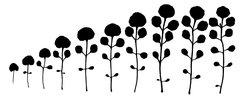The role of heterochronic variation in driving morphological diversity in C. hirsuta
Supervision: The project will be supervised by Miltos Tsiantis at the Max Planck Institute for Plant Breeding Research.
Abstract: A key challenge in biology is to understand the genetic basis and degree of repeatability of morphological evolution at different evolutionary scales. One way to address this problem is to compare the genetic basis for variation of diverse traits in different organisms. To facilitate such studies in plants, we developed the A. thaliana relative C. hirsuta into a model system for understanding diversification of leaf morphology. Leaf form can be classified as simple, where the leaf blade is entire like in the reference plant A. thaliana, or dissected (compound) where the blade is divided into leaflets like in C. hirsuta. So far, we have made the key observation that interspecific variation of leaf shape in C. hirsuta may be dominated by heterochronic pathways (1). To gain a more comprehensive understanding of species-wide phenotypic variation, we are at the final stages of curating a panel of >500 geo-referenced strains of C. hirsuta. We will phenotype this panel for leaflet number, terminal leaflet shape, flowering time and seed size and number. By statistical analysis of this dataset, we will explore whether heteroblastic variation is a strong predictor of leaflet number and whether seed traits which are of interest because of their ecological significance are under common control. We will also look for association of genetic polymorphisms with these traits. This approach will help quantify to what degree heterochrony contributes to species-wide diversity in leaflet number and identify allelic variants underlying this diversity. To add value to this panel, we will use available climatological data to look for clines in leaf shape and in this way test whether a correlation between leaf complexity and temperature - which exists broadly in extant angiosperms - and the paleontological record can be identified in this species-wide sample (2). This approach, together with population genetic studies and targeted field experiments, will help understand the adaptive value of leaf shape variation as well as the degree of trait integration and its adaptive significance. Of particular interest here will be the study of morphological features that are prevalent in Macaronesia. To understand how repeatable mechanisms underlying leaf evolution are, we will compare the candidate loci we identify with the above approaches, with those underlying natural variation in leaf margin morphology of A. thaliana (3,4) and variation between C. hirsuta and A. thaliana.
Link to the Tsiantis group homepage: https://www.mpipz.mpg.de/tsiantis
References:
(1) Cartolano M, et al. (2015) Heterochrony underpins natural variation in Cardamine hirsuta leaf form. Proceedings of the National Academy of Sciences of the United States of America 112(33):10539-10544.
(2) Royer DL, Wilf P, Janesko DA, Kowalski EA, & Dilcher DL (2005) Correlations of climate and plant ecology to leaf size and shape: potential proxies for the fossil record. American journal of botany 92(7):1141-1151.
(3) Huang X, et al. (2011) Analysis of natural allelic variation in Arabidopsis using a multiparent recombinant inbred line population. Proceedings of the National Academy of Sciences of the United States of America 108(11):4488-4493.
(4) Shen X, Pettersson M, Ronnegard L, & Carlborg O (2012) Inheritance beyond plain heritability: variance-controlling genes in Arabidopsis thaliana. PLoS Genet 8(8):e1002839.

